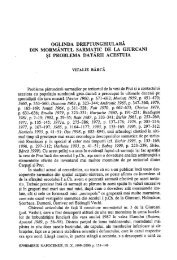EPHEMERIS NAPOCENSIS - Institutul de Arheologie Åi Istoria Artei
EPHEMERIS NAPOCENSIS - Institutul de Arheologie Åi Istoria Artei
EPHEMERIS NAPOCENSIS - Institutul de Arheologie Åi Istoria Artei
Create successful ePaper yourself
Turn your PDF publications into a flip-book with our unique Google optimized e-Paper software.
Instrumentum Balnei from Roman Napoca<br />
239<br />
handle appliqués <strong>de</strong>corated with Bacchic masks and a bronze handle 29 . The Royal-Athena Galleries<br />
from New York preserve in their collection an exquisite piece belonging to this category: an iron<br />
globular vessel with bronze base, provi<strong>de</strong>d with two loop shaped appliqués which allowed the<br />
attachment of a massive bronze chain, completely preserved. The most interesting part of the vessel<br />
is represented by the bronze lid: a representation of Venus Anadyomene as a child riding a dolphin 30 .<br />
From the category of iron flask-shaped vessels, the one which resembles the most with the<br />
vessel with base from Napoca (Pl. III/1, V/1, 2a–c) comes from Rottenburg am Neckar (Ba<strong>de</strong>n-<br />
Württemberg, Germany), being generally dated between the 2 nd and the 3 rd century AD. The object<br />
presents the same strongly arched body and in the area of the maximum diameter the joining line<br />
of the two hemispheric parts is still visible. It has two small handles ma<strong>de</strong> of iron attached un<strong>de</strong>r<br />
the rim, each of them preserving the first loop of the bronze hanging chain. The rim is vertical and<br />
it was ma<strong>de</strong> out of bronze or brass 31 . Two other examples were i<strong>de</strong>ntified in funerary contexts from<br />
Pannonia Inferior. The first one was discovered in 1935 at Vajta (Fejér county, Hungary) associated<br />
with a strigilis, in a wagon-grave disturbed by mo<strong>de</strong>rn activities. This vessel shows a very strong<br />
resemblance with the second iron vessel from Napoca (Pl. VI/1, VIII/1a–d, IX/1a–d, 2, 3). It has<br />
a vertical rim covered with a plate of bronze, two small handles attached un<strong>de</strong>r the rim which both<br />
preserve the first loop of a bronze chain, a narrow neck and a spherical body en<strong>de</strong>d in the lower<br />
part with the same small protuberance 32 . The only difference from the vessel discovered at Napoca<br />
is represented by the presence of a ring-shaped base, but if one takes into consi<strong>de</strong>ration the fact<br />
that the lowest point of the body is arched and marked with a knob, it can not be exclu<strong>de</strong>d that<br />
initially the vessel did not have a base and that it was ad<strong>de</strong>d subsequently, during its usage period,<br />
in or<strong>de</strong>r to allow it to remain in a vertical position. The other iron vessel known from Pannonian<br />
contexts comes from the necropolis at Intercisa (Dunaújváros, Fejér county, Hungary), without the<br />
possibility of a closer dating. The object is flask-shaped, with a narrow neck and a reverted rim.<br />
The maximum diameter is located in this case in the lower part of the body 33 .<br />
Taking into account the rarity of such objects and the raw material they were ma<strong>de</strong> of, the<br />
question that arises related to the shape, is whether they represent original items or they imitate<br />
shapes which are common in other categories of material. The morphology presented by the first<br />
vessel from Napoca (Pl. III/1, V/1, 2a–c) can be easily traced, since it has the same characteristics<br />
as a certain type of copper alloy flask-shaped toilette vessel, ma<strong>de</strong>, usually, from two pieces of metal<br />
which are joined above the shoul<strong>de</strong>r, with globular body and narrow neck, typical for the Roman<br />
provinces during the 2 nd and 3 rd centuries AD 34 . An important characteristic of the type is the<br />
closing system of the lid, consisting of, as above mentioned, two plates of metal: a lower one set<br />
into the rim and a mobile upper one. Such system can be observed on some better preserved pieces<br />
like the one from Rainau-Buch 35 or the one from Calvatone (Lombardy, Italy) 36 .<br />
Concerning the second vessel (Pl. VI/1, VIII/1a–d, IX/1a–d, 2, 3), even if it displays<br />
the same lid mechanism, its shape does not show resemblance with other type of vessels ma<strong>de</strong><br />
of metal. At a first glance it can be noticed a similarity with glass toilette vessels belonging to<br />
the type Isings 61 37 , but there are some differences: in our case the rim is not flattened and<br />
29<br />
BARATTE ET AL. 1984, 128–129, no. 199, Pl.: LX/199; LXXVI/199; BONNAMOUR 2000, 41, 131 no. 204.<br />
30<br />
The vessel is offered for sale and can be accessed at the following internet address: http://www.royalathena.<br />
com/pages/RomanCatalog/Bronze/Vessels/GMZ15.html (10.03.2012).<br />
31<br />
SEITZ 2005, 362 Abb. 483.<br />
32<br />
FÜLEP 1949, 41–42, 28. tábla/1–3.<br />
33<br />
RADNÓTI 1957, 191, 218 no. 22, Pl. XXXIX/11; SZIRMAI 1993, 422, 427, Fig. 7/6.<br />
34<br />
SEDLMAYER 1999, 42, Taf. 16/11–14 with an overview of the finds and the bibliography; CASTOLDI<br />
2002, 300–303; BIENERT 2007, 232–233, 237–239, nos.: 271–273.<br />
35<br />
PLANCK 1983, 332 Abb. 134/1.<br />
36<br />
CASTOLDI 2002, 301, fig. 12, 303, fig. 16.<br />
37<br />
ISINGS 1957, 78–80.















